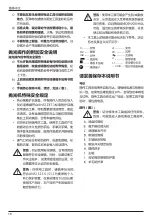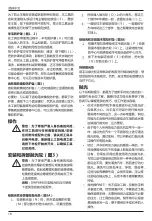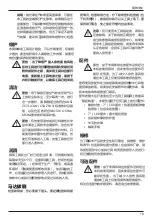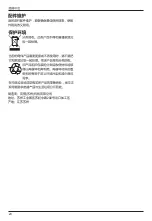
E N G L I S H
9
continue to run. To turn the tool off from a locked-
on position, squeeze and release the trigger switch
once. Do not unplug the tool with the switch in
the locked-on condition. Make sure the tool is not
locked on when plugging in. If the tool is plugged
back in with the switch in the locked-on position, the
tool will not run until the lock button (G) is depressed
(no-volt release).
NOTE:
The trigger switch can only be locked
on with the tool running at the maximum RPM
designated by the speed control wheel (A).
Speed control Wheel (fig. 1)
The maximum speed of your tool can be changed
by rotating the speed control wheel (A) to the
desired setting. The wheel incorporates detents to
prevent inadvertent wheel movement and to facilitate
speed selection. For added versatility, the trigger
switch may be locked in its full on position and tool
speed changed by means of the speed control
wheel (A) alone.The electronic speed control not
only lets you select the speed to suit the job, but
also helps to maintain that speed as you load the
tool by pressing down. It’s this feature, coupled with
the variable speed trigger switch, that make this tool
such a value.
The speed control wheel (A) can be set for any
speed between 600 and 3500 RPM and the variable
speed switch will then control tool speed from zero
to the wheel setting. For example: A control wheel
setting of 2200 RPM will allow the variable speed
switch to operate the tool between zero and 2200
RPM, depending on how far the trigger switch is
depressed. A wheel setting of 600 RPM would allow
the switch to operate the tool from zero to 600
RPM.
The electronic speed control feature comes into play
whenever the trigger switch is fully depressed and
the tool is running at the selected speed determined
by the setting of the control wheel. As you load the
tool by pushing it down on the work surface, (with
the trigger fully depressed) the electronic circuit
inside the tool will compensate for the loading and
maintain the selected speed. If the speed selected
by the control wheel is 2200 RPM, as in the
example above, the tool will maintain 2200 RPM, as
it is loaded.
It is important to remember two things about
electronic speed control:
1.
The electronic speed control operates only
when the trigger switch (C) is fully depressed.
2. The effect of electronic speed control is much
easier to observe at lower speed settings
(2600 RPM and below), than at high speeds.
As the tool approaches 3000 RPM, the effect
is considerably less dramatic.
Keep in mind that, with a conventional polisher
running at a typical no-load speed of 2400 RPM,
the tool slows down to about 2000 RPM under a
polishing load. Your DWP894X will continue to run
at 2400 RPM (or any speed you select with the
control wheel) as a load is applied. Since it doesn’t
slow down, the speed may be greater than you’re
used to, so some extra caution should be observed
until you get the “feel” of your polisher. If you feel the
speed is too great, you can, of course, slow the tool
down with either the trigger switch or the control
wheel.
Spindle Lock Button (fig. 1)
å å
WARNING:
ååå
4O¬REDUCE¬THE¬RISK¬OF¬
SERIOUS¬PERSONAL¬INJURY¬TURN¬TOOL¬OFF¬
AND¬DISCONNECT¬TOOL¬FROM¬POWER¬
SOURCE¬BEFORE¬MAKING¬ANY¬ADJUSTMENTS¬
OR¬REMOVINGINSTALLING¬ATTACHMENTS¬OR¬
ACCESSORIES¬"EFORE¬RECONNECTING¬THE¬
TOOL¬DEPRESS¬AND¬RELEASE¬THE¬TRIGGER¬
SWITCH¬TO¬ENSURE¬THAT¬THE¬TOOL¬IS¬OFF
In order to prevent the spindle of the tool from
rotating while installing or removing accessories, a
spindle lock button (E) has been provided in the gear
head of the machine. To lock the spindle, depress
and hold the lock button. NEVER DEPRESS
THE SPINDLE LOCK BUTTON WITH THE TOOL
RUNNING OR COASTING.
Wool Ingestion Shields (fig. 1, 2)
The wool ingestion shields (K) are designed to
reduce the amount of wool, dust, and debris that
gets ingested by the motor during normal use. The
goal of the ingestion shields is to improve durability
as compared to a unit without the ingestion shields.
Each ingestion shield can be easily removed for
cleaning by removing the mounting screw (L),
followed by sliding the shield back towards the
trigger end of the tool and then lifting it off. The wool
ingestion shields can be cleaned with soap and
water and a soft bristle brush in the event they get
clogged with polish and debris. Clean the shields
as soon as you start to see buildup on the outside.
Your tool may come with a set of wool ingestion
shields. The wool ingestion shields are available
at extra cost from your local dealer or authorized
service center.
Summary of Contents for DWP849XD
Page 1: ...DWP849XD ...
Page 2: ...English original 4 13 ...
Page 3: ...C H E I D G A K J E A K L FIG 2 2 FIG 1 1 2 ...
Page 4: ...P Q I E E FIG 3B 3B 3 M N O I E FIG 3A 图3A ...
Page 7: ...ENGLISH 6 5 SERVICE Safety instructions for All operations ...
Page 14: ...13 220 1250 50 M14 3 0 DWP849XD 0 600 0 3500 D ...
Page 17: ...16 V A Hz W min n r min ...
Page 18: ...17 ...
Page 19: ...18 ...
Page 21: ...20 制造商 百得 苏州 科技有限公司 地址 苏州工业园区苏虹中路200号出口加工区 产地 江苏苏州 ...
Page 22: ......
Page 23: ......
Page 24: ...N511048 02 2017 ...










































